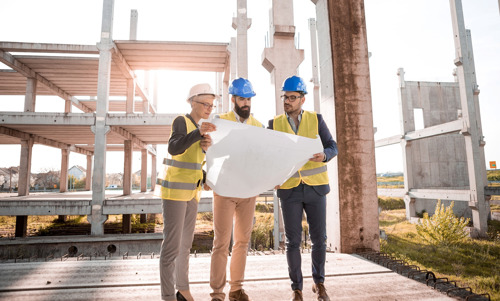4 important factors to succeed with your renovation

Many buildings that reach the end of the lifespan they were originally designed for can look forward to new life to renew outdated areas. They can even be transformed and changed to fill a whole new role!
For a variety of reasons, it is becoming more and more popular to renovate existing buildings than to demolish and rebuild older facilities. However, old buildings can be a challenging project, often with hidden secrets that can make an otherwise simple job extremely complicated. We look at four key factors that will ensure your next renovation project is a success.
Buildings that are truly made to last can be expected to fulfill several different purposes over time. We see this today in many large and small cities, where centuries-old production and commercial buildings are transformed into apartments, shops, offices and sometimes valuable community facilities such as recreation centers, museums and daycare centers.
Today, many industries are facing increasing pressure to recycle buildings instead of demolishing them and building new ones. There can be many reasons for this, such as a desire not to harm the environment and emit CO2 in connection with a new building, or it can be due to planning, time saving or space reasons.
But it is something of an art to breathe new life into an old building, and it takes a lot of expertise and technology to achieve a successful result. To help make your next renovation as straightforward as possible, whether it's a major renovation or just an update to worn or old components, we've put together a list of our top four tips for a successful project.
1 – There's nothing that beats physical presence
Compared to new constructions, renovations do not start with a basic blueprint, as there is already a complex structure that needs to be thoroughly familiarised before the new plans can be completed.
Compared to new constructions, renovations do not start with a basic blueprint, as there is already a complex structure that needs to be thoroughly familiarised before the new plans can be completed.
It is therefore important to be physically present on site so that you can inspect the building yourself. In that process, it is important to ask a lot of questions such as what are the walls made of? Are there any loose bricks or installations? What repairs, upgrades, and changes have been made in the past? Is there a need to install a heating, ventilation and air conditioning system? What U-value does the building have and does it live up to the standard? If not, how can it be improved? How are the windows positioned and is there a need for new windows? If new windows are needed, should they be placed elsewhere if a new façade is to be built? Will the physical condition of the building still hold up after the renovation? The list is almost endless!
If the material manufacturer is on site with you, he or she can answer these questions and thus best advise you on how to proceed. A product that would normally work may not fit the real situation and the supplier may recommend alternatives that will work much better. The supplier can also work with the architect, client and execution teams to ensure that the proposed design, schedule and offer are as accurate as possible.
Renovation projects are also prone to completely unforeseen problems ranging from the discovery of hidden construction problems and bad pipes to inadequate wiring, poor ventilation and moisture problems. It will be a great help to have a supplier who can provide specialised technical assistance as well as regularly visit the site when necessary so that any problems that arise can be resolved and all stakeholders thus achieve the very best results.
2 – Find the right system for the task at hand
Choosing the right building materials for the first time will make the project more reliable and robust, avoiding errors in installation or soon after completion, which would otherwise cause both the schedule and budget to slip.
Here, compatibility is an important issue, because a product that may work well in a showroom may not work properly in that situation or in combination with other components and materials. To avoid this problem, the supplier can advise on an entire system that takes into account not only the product in question, but also how it interacts with the environment.
It is also an advantage to work with a supplier who can offer a comprehensive range of products, as you can thus review several options until the best solution is found. At CPG, our range of sealants for windows includes not only silicone, but a wide product range, so we can offer tailor-made and customized solutions. The wide range of products also makes it easier to control the entire process, as only one connector is required for several systems. In addition, our in-house R&D department can help create a tailor-made solution if challenges arise that we have not encountered before.
3 – Always have the right information for the task at hand
There is no point in choosing highly sophisticated products if no one understands how they work or how they are installed. Renovation projects are complicated enough in advance, without having to worry about improper use, and if the work cannot be easily checked on the construction site, the risk increases.
Products that are simple and easy to understand make it easier to share relevant information and ensure that all installers know what they are doing. It can be invaluable to work with a manufacturer who can help train fitters and make sure they understand the product and how to get the most out of it to avoid on-site problems.
At CPG Europe, we work hand in hand with installers in several different ways. This includes not only hosting dedicated trainings and workshops on our product brands, but also offering toolkits, site visits to inspect work in progress, and engaging in solving tricky details.
And it's not just installers who should be sure to have the right information at the right time. For example, architects require access to complex information on all components to prepare their highly detailed plans. A good example is our brand Dryvit's exterior insulation and coating systems, where it is important that we can offer the architect the necessary calculations of wind load and requirements for insulating properties. The information must not only be accurate, but must also often be in the correct format, such as CAD drawings or BIM files, so that they can be inserted into the design.
Finding a manufacturer that enables simple, streamlined communication between all parties is a key benefit throughout the project.
4 – A plan for the future
The long-term viability of the building must be recognized early in the project. This means understanding the lifespan of the building's new purpose, whether it is a factory being converted into an office or an old municipal building being converted into apartments, and knowing the upcoming trends and legislation to be considered.
The work to create more efficient and sustainable buildings is an important example, as renovated buildings have to meet much higher energy efficiency requirements than when they were originally built. More emphasis is also placed on choosing advanced environmentally friendly products, such as manufactured, transported and installed with minimal CO2 emissions.
The choice of specifications can also affect the ongoing sustainability levels on the construction site: hygienic and easy-to-clean floors reduce water consumption, for example, low-energy lighting limits the need for electricity, and a durable façade with thermal properties keeps the heating requirement at a low level.
If you get these things under control, you can ensure that the investment in the renovation provides value for money and that it lives up to the owner's long-term goals.










